您好,登錄后才能下訂單哦!
您好,登錄后才能下訂單哦!
小編給大家分享一下C++ 數據結構中單鏈表的示例分析,希望大家閱讀完這篇文章之后都有所收獲,下面讓我們一起去探討吧!
鏈表是一種物理存儲結構上非連續、非順序的存儲結構,數據元素的邏輯順序是通過鏈表中的指針鏈接依次實現的。
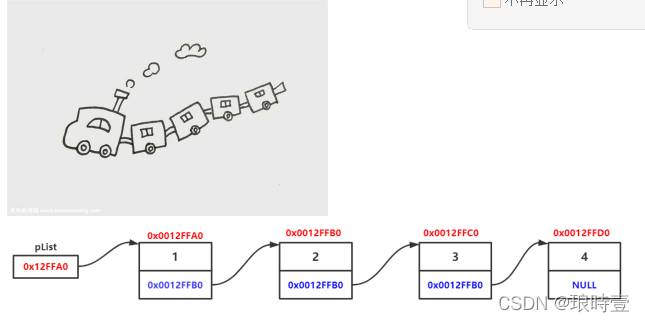
由圖,鏈式結構在邏輯上是連續的,但是物理上不一定連續
顯示中結點一般是從堆上申請出來的
從堆上申請的空間,是按照一定的策略劃分的,兩次申請的空間,可能連續,可能不連續,見順序表
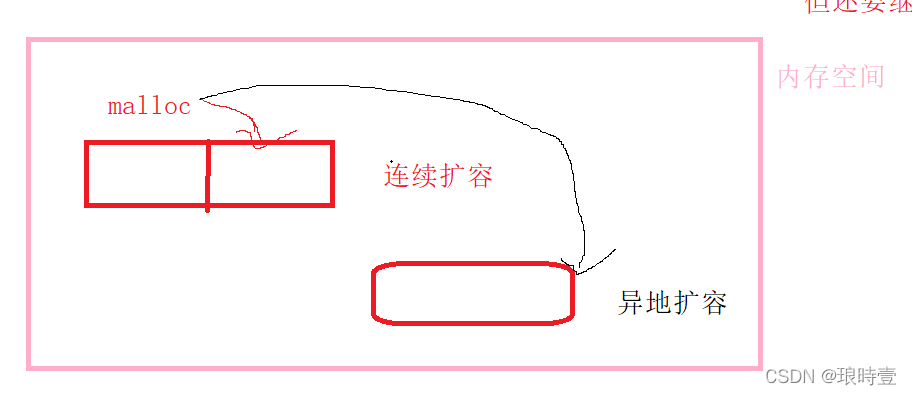
鏈表也可以分為很多種
1. 單向或者雙向
2. 帶頭或者不帶頭
3. 循環或非循環

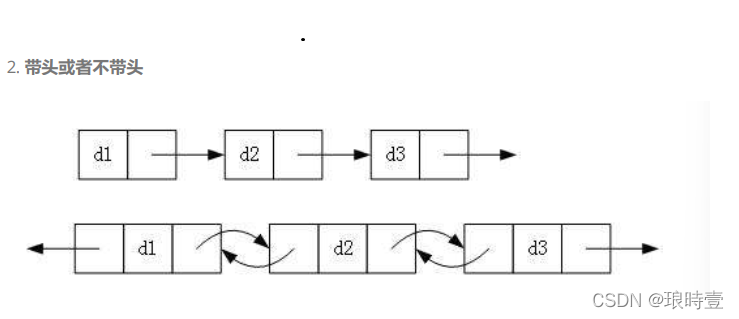
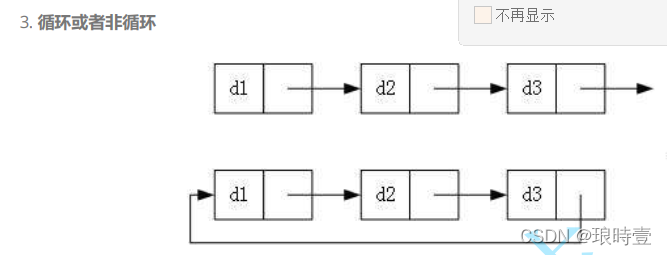
我們最常用的還是無頭單向非循環鏈表和帶頭雙向循環鏈表 本篇我們實現無頭單向非循環鏈表增刪查改
基本結點結構
typedef int SLTDateType;
typedef struct SListNode
{
SLTDateType data;
struct SListNode* next;
}SListNode;頭文件
//llist.h
#pragma once
#include <stdio.h>
#include <assert.h>
#include <stdlib.h>
#include <string.h>
typedef int SLTDateType;
typedef struct SListNode
{
SLTDateType data;
struct SListNode* next;
}SListNode;
// 動態申請一個節點
SListNode* BuySListNode(SLTDateType x);
// 單鏈表打印
void SListPrint(SListNode* plist);
// 單鏈表尾插
void SListPushBack(SListNode** pplist, SLTDateType x);
// 單鏈表的頭插
void SListPushFront(SListNode** pplist, SLTDateType x);
// 單鏈表的尾刪
void SListPopBack(SListNode** pplist);
// 單鏈表頭刪
void SListPopFront(SListNode** pplist);
// 單鏈表查找
SListNode* SListFind(SListNode* plist, SLTDateType x);
// 單鏈表在pos位置之后插入x
// 分析思考為什么不在pos位置之前插入?
void SListInsertAfter(SListNode* pos, SLTDateType x);
// 單鏈表刪除pos位置之后的值
// 分析思考為什么不刪除pos位置?
void SListEraseAfter(SListNode* pos);
// 單鏈表的銷毀
void SListDestory(SListNode* plist);動態申請一個節點

// 動態申請一個節點
SListNode* BuySListNode(SLTDateType x)
{
SListNode* newnode = (SListNode*)malloc(sizeof(SListNode));
if (newnode == NULL)//申請失敗
{
printf("malloc fail\n");
exit(-1);
}
else
{
newnode->data = x;
newnode->next = NULL;
}
return newnode;
}單鏈表打印
鏈表單個結點中,data存儲數據,next存儲下一個結點的地址,可以通過next訪問下一個結點
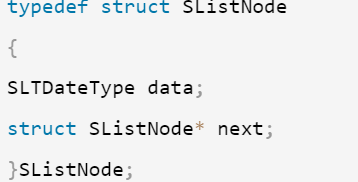

// 單鏈表打印
void SListPrint(SListNode* plist)
{
SListNode* cur = plist;
while (cur != NULL)
{
printf("%d->", cur->data);
cur = cur->next;//訪問下一個結點
}
printf("NULL\n");
}單鏈表尾插

這里傳入了頭結點的地址的指針,是因為有可能要改變頭結點的情況,傳址調用幻術,如果只傳入*plist,相當于只改變形參,實參不會有實際改變,通過pplist可以解決這個問題

// 單鏈表尾插
void SListPushBack(SListNode** pplist, SLTDateType x)
{
SListNode* newnode = BuySListNode(x);
if (*pplist == NULL)//空鏈表
{
*pplist = newnode;
}
else
{
SListNode* tail = *pplist;//遍歷至最后插入
while (tail->next != NULL)
{
tail = tail->next;
}
tail->next = newnode;
}
}單鏈表的尾刪
一前一后遍歷,找到空后直接free(tail),將prev->next置空即可

// 單鏈表的尾刪
void SListPopBack(SListNode** pplist)
{
assert(pplist);
if (*pplist == NULL)//空鏈表,無需刪除
{
return;
}
else
{
SListNode* prev = NULL;
SListNode* tail = *pplist;
{
while (tail->next != NULL)
{
prev = tail;
tail = tail->next;
}
free(tail);
tail = NULL;
prev->next = NULL;
}
}
}單鏈表的頭插

有點繞,要多想想
// 單鏈表的頭插
void SListPushFront(SListNode** pplist, SLTDateType x)
{
assert(pplist);
SListNode* newnode = BuySListNode(x);
newnode->next = *pplist;
*pplist = newnode;
}單鏈表頭刪

比較簡單
// 單鏈表頭刪
void SListPopFront(SListNode** pplist)
{
assert(pplist);
if (*pplist == NULL)//鏈表為空
{
return;
}
else
{
SListNode* next = (*pplist)->next;
free(*pplist);
*pplist = next;
}
}// 單鏈表查找
遍歷即可
SListNode* SListFind(SListNode* plist, SLTDateType x)
{
SListNode* cur = plist;
while (cur != NULL)
{
if (cur->data = x)
{
return cur;
}
cur = cur->next;
}
retuen NULL;
}*單鏈表在pos位置之后插入x
為什么不在pos之前插入,由于我們是單向鏈表,需要從頭遍歷查找pos,如果在pos之前插入,找到pos還需找到pos之前的地址,對所傳參數不友好,所以我們一般在后插入
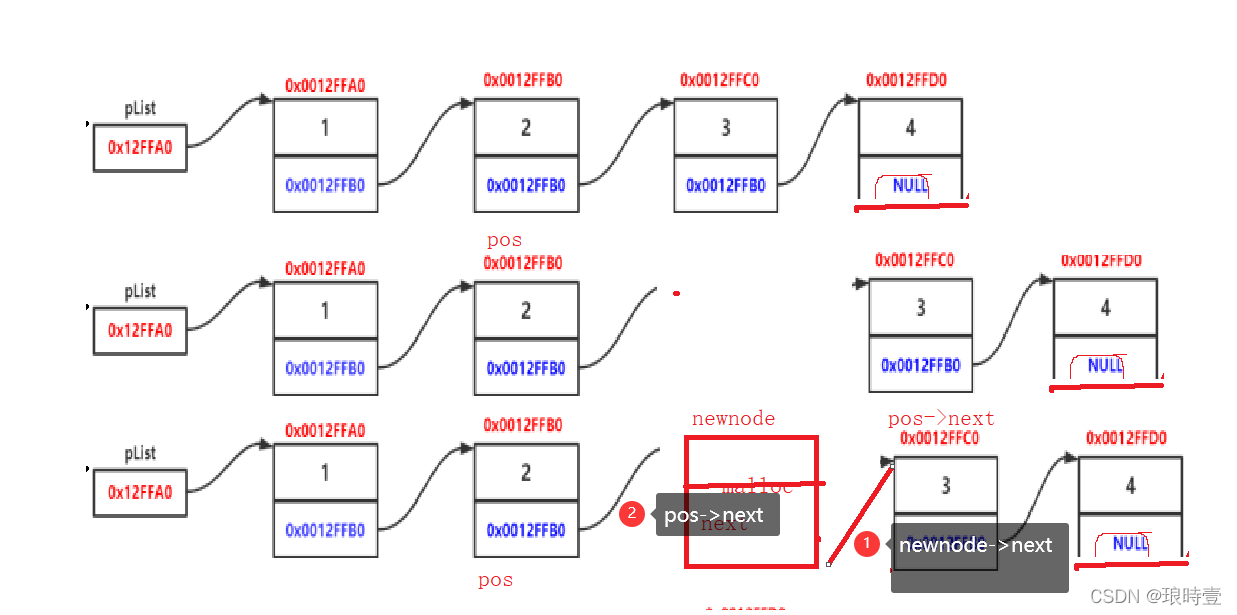
//單鏈表在pos位置之后插入x
void SListInsertAfter(SListNode* pos, SLTDateType x)
{
assert(pos);
SListNode* newnode = BuySListNode(x);
newnode->next = pos->next;
pos->next = newnode;
}單鏈表刪除pos位置之后的值 為什么不刪除pos位置,同上,在邏輯上和傳參不友好.

// 單鏈表刪除pos位置之后的值
void SListEraseAfter(SListNode* pos)
{
assert(pos);
SListNode* next = pos->next;
if (next)
{
pos->next = next->next;
free(next);
next = NULL;
}
}單鏈表的銷毀 鏈表不像順序表連續刪頭就可以,由于鏈表是一個一個分散的結點,需要逐一刪除
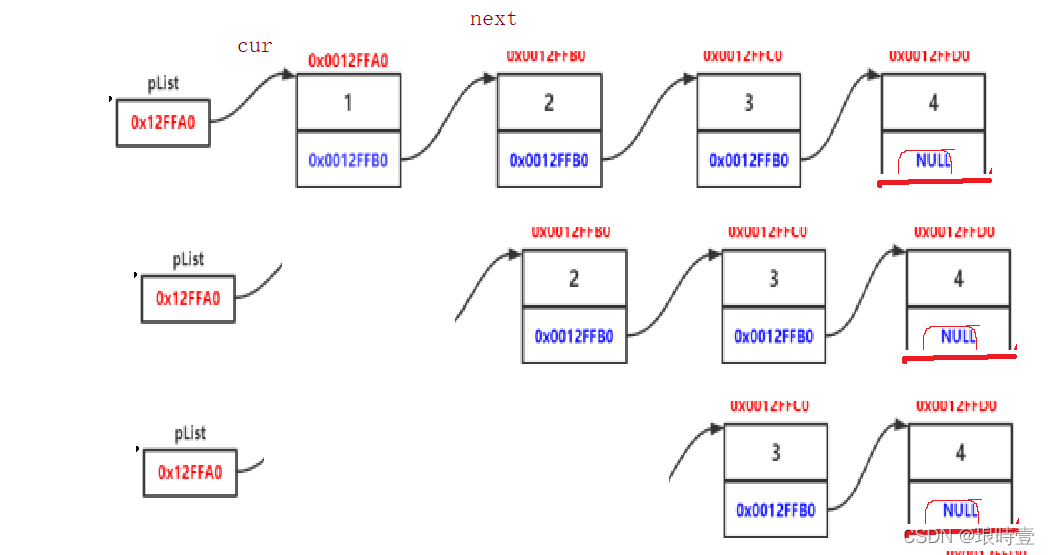
// 單鏈表的銷毀
void SListDestory(SListNode** pplist)
{
assert(*pplist);
SListNode* cur = *pplist;
while (cur)
{
SListNode* next = cur->next;
free(cur);
cur = next;
}
*pplist = NULL;
}看完了這篇文章,相信你對“C++ 數據結構中單鏈表的示例分析”有了一定的了解,如果想了解更多相關知識,歡迎關注億速云行業資訊頻道,感謝各位的閱讀!
免責聲明:本站發布的內容(圖片、視頻和文字)以原創、轉載和分享為主,文章觀點不代表本網站立場,如果涉及侵權請聯系站長郵箱:is@yisu.com進行舉報,并提供相關證據,一經查實,將立刻刪除涉嫌侵權內容。